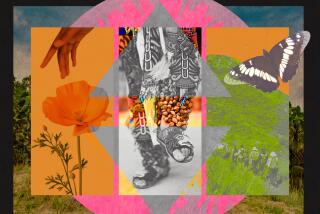Zapotec in 90006, K’iche’ in 90057: New map highlights L.A.’s Indigenous communities
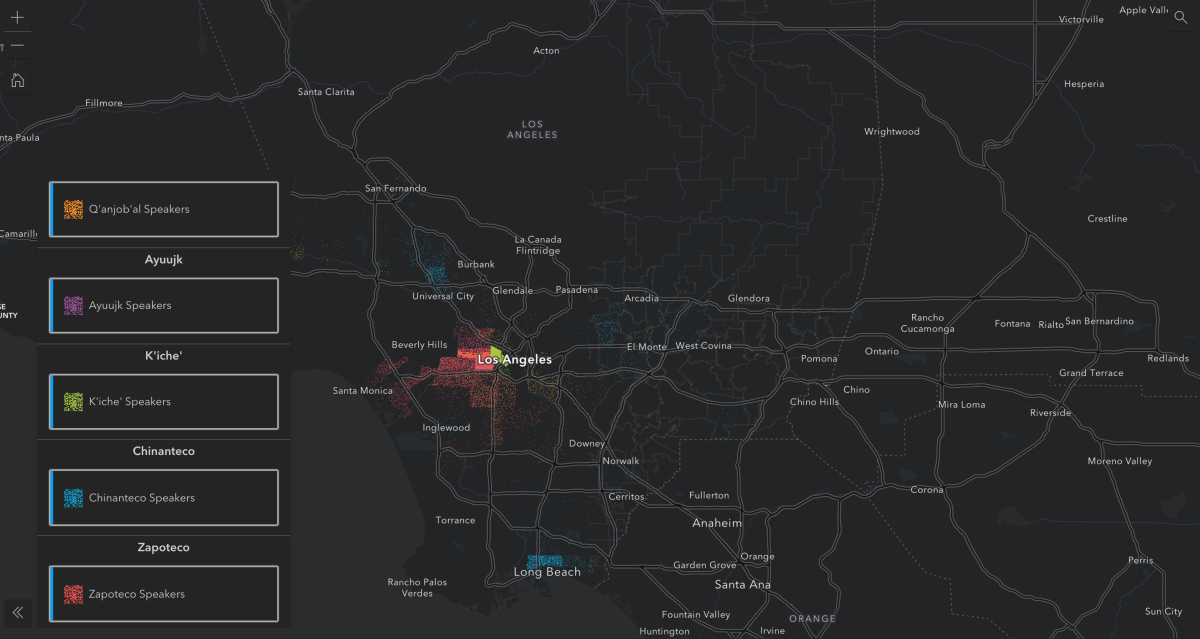
It’s not the kind of Los Angeles County map people expect to see.
Instead of geographic markers, it shows languages.
The Pico-Union and Westlake areas light up with red and green dots for households that speak Oaxacan Zapotec and Mayan K’iche’. Blue dots pepper Long Beach for Chinantec speakers, also from Oaxaca.
CIELO, a local organization whose Spanish acronym stands for Indigenous Communities in Leadership, collected the data during the COVID-19 pandemic to try to bring greater attention to Latin American Indigenous people who are often labeled as Latino but may have only a basic grasp of Spanish. Advocates say schools, hospitals, courts and police should pay more attention to these language barriers because miscommunication, or failing to provide an interpreter, can have dire consequences.
“We do exist,” said Odilia Romero, co-founder of CIELO, who came to L.A. at age 10 from the Oaxacan town of San Bartolomé Zoogocho. “There’s an assumption that everyone south of the border is Latinx and they speak Spanish, and that is not true.”
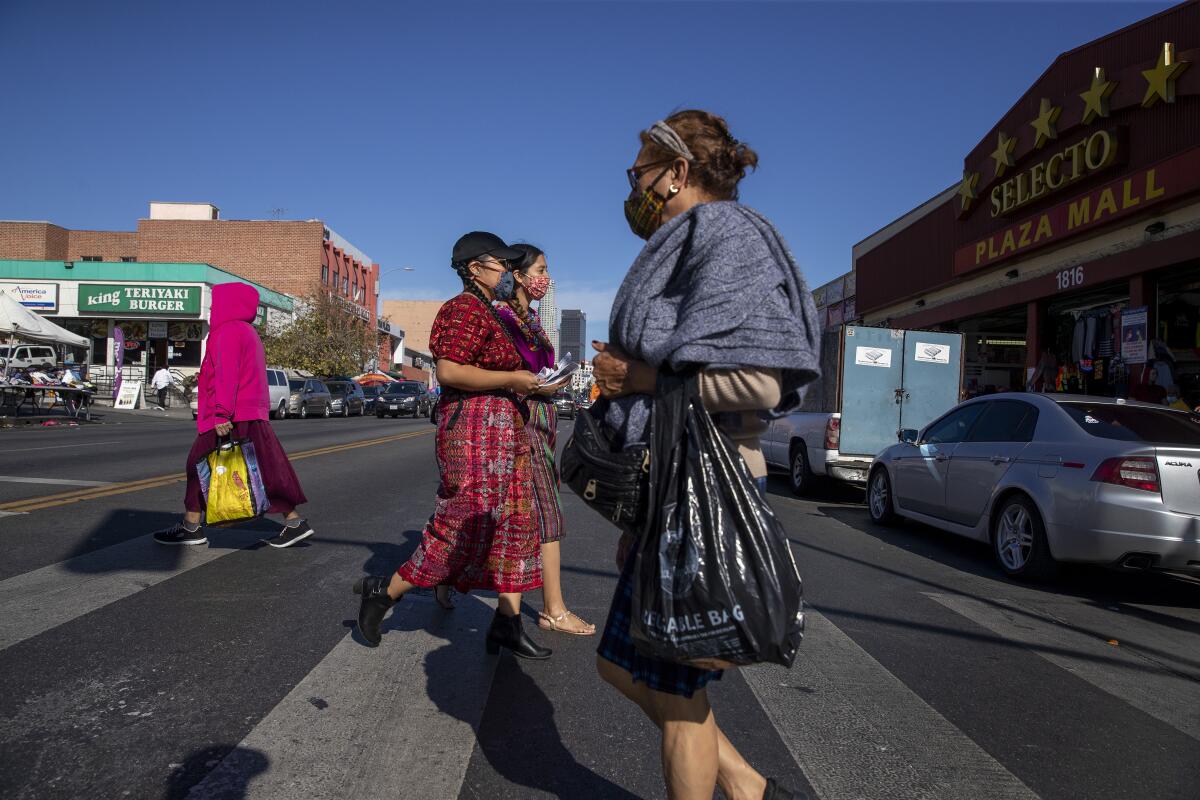
About 20% of Mexico’s population considers itself Indigenous; in Guatemala, more than 40% of residents identify as Maya.
The languages they speak can be as different from Spanish as Chinese is from English, and can contain dozens of variants. There are 32 Mayan languages, for example, according to Danny Law, a linguist at the University of Texas at Austin.
Some of the early migratory networks of Indigenous Mexicans to California were established during the bracero program, a 1942 agreement between the United States and Mexico that brought in millions of Mexican men to work in agriculture. They continued after the program ended in 1964.
But it wasn’t until the 1980s that Indigenous Oaxacans began to settle increasingly in the U.S. after the devaluation of the Mexican peso. Many Indigenous Guatemalans also fled to California as refugees during the country’s civil war.
The U.S. census does not track the number of people from Mexico and Guatemala who speak Indigenous languages. The 2010 Indigenous Farmworker Study, done in collaboration with California Rural Legal Assistance, or CRLA, estimated a total of 165,000 Indigenous farmworkers and family members in California — a projection based on interviews with people from 342 Mexican hometowns as well as data from the National Agricultural Workers Survey by the U.S. Department of Labor.
Researchers have placed the number of Latin American Indigenous people in Southern California significantly higher.
Raúl Hinojosa-Ojeda, a professor at UCLA’s Department of Chicana and Chicano Studies, has estimated as many as 200,000 Zapotecs live in L.A. County based on interviews with hometown associations and their corresponding villages in Oaxaca, as well as consular data on where migrants who have left Mexico live.
Eric Campbell, a linguist at UC Santa Barbara, said that estimating the population is difficult because immigrants may be reluctant to reveal they speak an Indigenous language — fearing discrimination — or may not think it relevant.
The burden ends up falling largely on Indigenous nonprofits to provide interpreter services and do outreach during emergencies such as wildfires and the pandemic. U.S.-born children often interpret for their parents.
“Much of what we see is Indigenous language speakers trying to get by in Spanish — that’s because a service provider is ignoring a request for interpreting, ignoring that person isn’t proficient in that language, or maybe it isn’t clear,” said Marisa Lundin, legal director of the Indigenous program at CRLA.
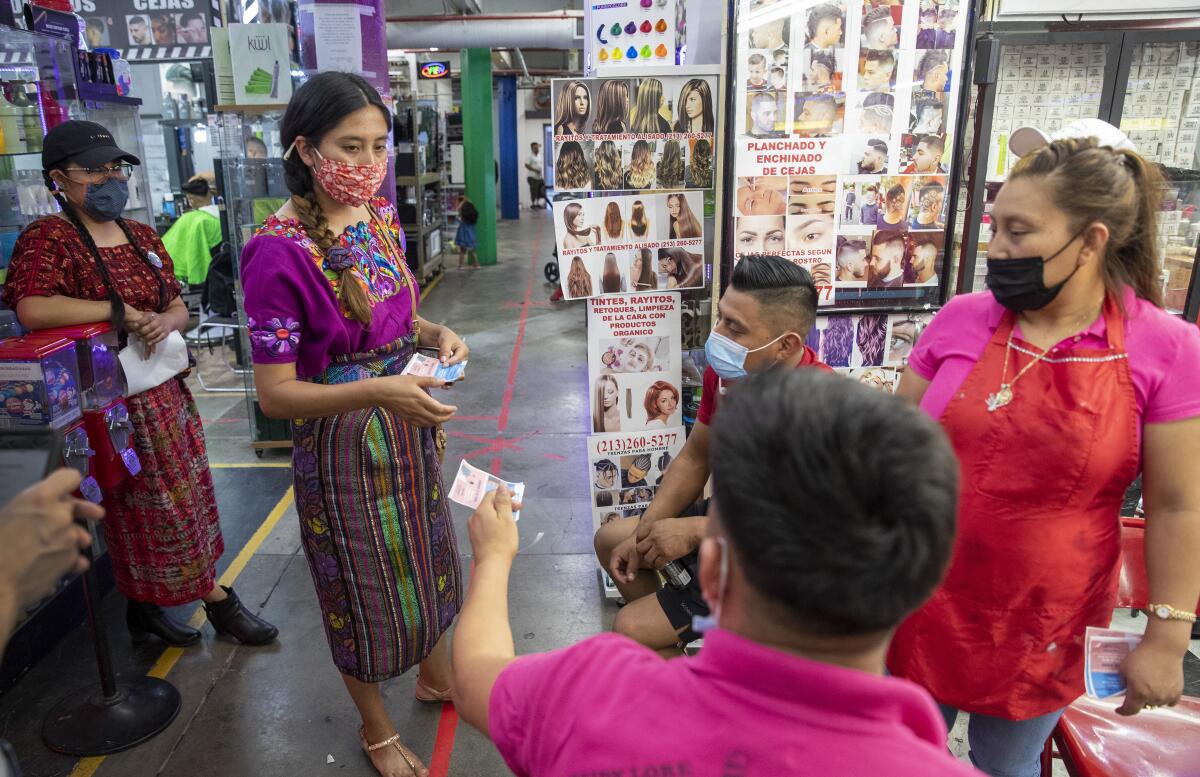
During the pandemic, CIELO distributed cash assistance to several thousand Indigenous families who are living in the U.S. without documents, some of whom missed vital information about the pandemic because of language barriers.
Community members spread the word about the financial aid in factories and restaurants, said CIELO co-founder Janet Martinez.
“We had Zapotecs asking for K’iche’s, K’iche’s asking for Chinantecos, Chinantecos asking for other Indigenous communities,” she said.
Seeing an opportunity, CIELO also surveyed these households and worked with UCLA to create two virtual maps that show the ZIP Codes where families that speak Indigenous languages live.
One reflects about 2,500 households that received financial assistance from the nonprofit. The other represents nearly 1,300 of those households where at least one member said they prefer to speak an Indigenous language. The density maps plot the members of each household and assumes that they have the same language preferences as the person from the household who completed CIELO’s survey.
Zapotec, Chinantec, K’iche’, Mixe and Q’anjob’al lead among more than a dozen languages represented, said Mariah Tso, a Navajo UCLA cartographer who worked on the project.
Most Zapotec speakers were concentrated in the Pico-Union and Koreatown areas, with most K’iche’ speakers in the Westlake area. Of those surveyed, 44% said they worked in the restaurant industry, followed by 29% in the cleaning sector and 11% in clothing factories.
Brenda Nicolas, a Zapotec professor at Loyola Marymount University whose research focuses on Latin American Indigenous diasporas, said the concentration of families in neighborhoods such as Central L.A. reflect migratory networks that have stayed together to maintain their culture.
Children participate in traditional dances and Oaxacan brass bands. Hometown associations hold party fundraisers for infrastructure developments back in their communities in Mexico.
CIELO did not mandate income levels for the families it helped. But Gaspar Rivera-Salgado, director of UCLA’s Center for Mexican Studies, said that since the map reflects those who received cash assistance, it probably leaves out middle-class Indigenous families.
“The more we know and identify and create policies that target the most vulnerable population, the better the public policies would be,” he said.
Activists point to other areas, such as school districts, where it would be useful to have better data on Latin American Indigenous students.
The L.A. Unified School District said that for the 2020-21 school year, mandatory surveys in which families are asked to indicate a student’s primary or home language identified 247 for K’iche’, 88 for Q’anjob’al, 21 for Mam, 17 for Akateco, 12 students for Zapotec, one for Popti and three for Mixtec. More than 218,000 listed Spanish.
Marcos Aguilar, head of the Anahuacalmecac World School in El Sereno — a K-12 school that teaches Nahuatl, a language native to Mexico — said that’s a gross undercount. He said the numbers are probably in the tens of thousands given the significant portion of Mexico’s population that identifies as Indigenous.
Better data collection, he said, could ensure that families that primarily speak an Indigenous language are offered the support that they need and help educators evaluate the creation of Indigenous language programs. The school district’s Board of Education voted last month to appropriate $10 million to support Indigenous students.
“Right now what we’re facing is a massive invisibility within the district,” he said. “Nobody knows how many Indigenous students are enrolled in LAUSD schools.”
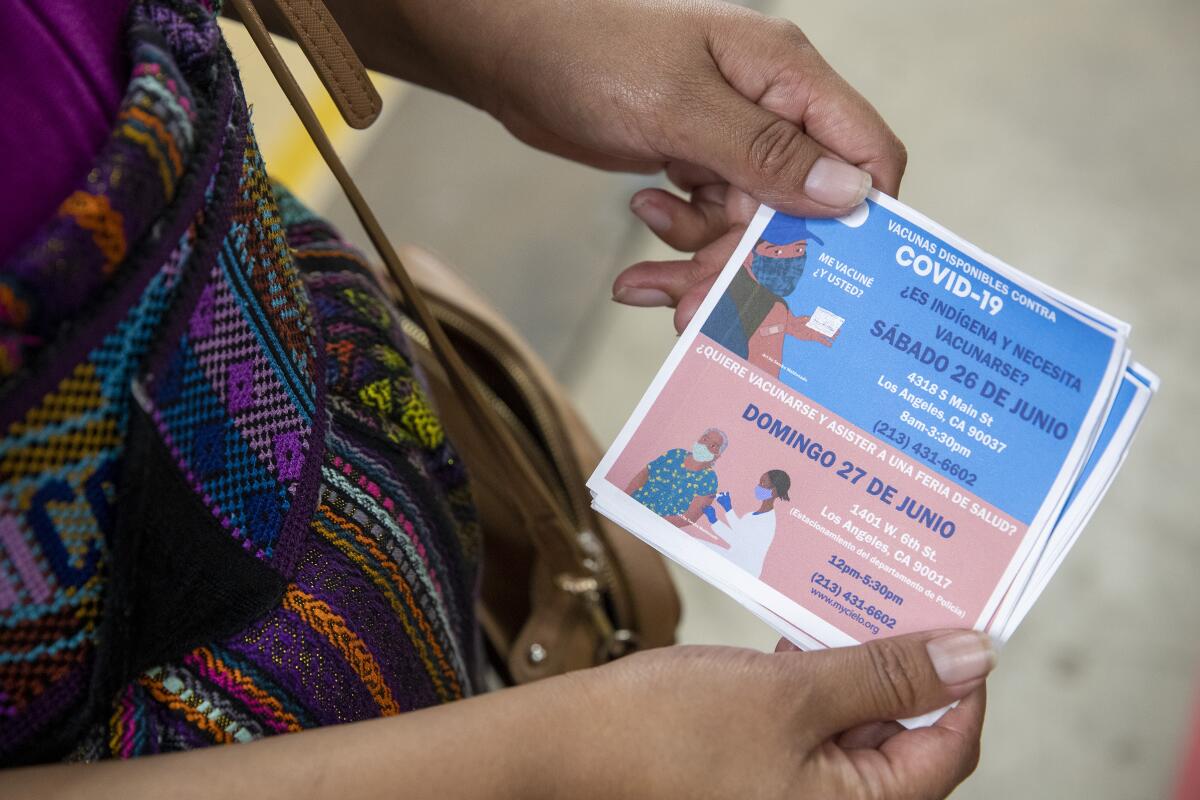
Indigenous activists have already worked with government agencies to address language barriers. In 2019, CIELO partnered with Los Angeles police to provide pocket cards for officers that can help them identify an Indigenous language speaker and, if necessary, call an interpreter. The initiative grew out of years of training by Indigenous Mexican community leaders for LAPD officers following the 2010 fatal shooting of Manuel Jaminez Xum, an Indigenous Maya man who spoke K’iche’.
CIELO says that its vaccine outreach campaign, which has helped more than 2,000 people get appointments, shows why data are crucial. Martinez said they shared the map with county health officials to advocate for a mobile vaccination site for Indigenous residents.
On a recent hot Saturday afternoon, CIELO staffers Aurora Pedro, who speaks the Mayan language Akateco, and Alba Gonzalez, who speaks K’iche’, met by MacArthur Park in Central L.A. to begin their outreach.
They asked fruit juice and clothing vendors lining the sidewalk if they had gotten the COVID-19 vaccine. Most had and accepted some fliers with information on vaccination sites to keep at their stands.
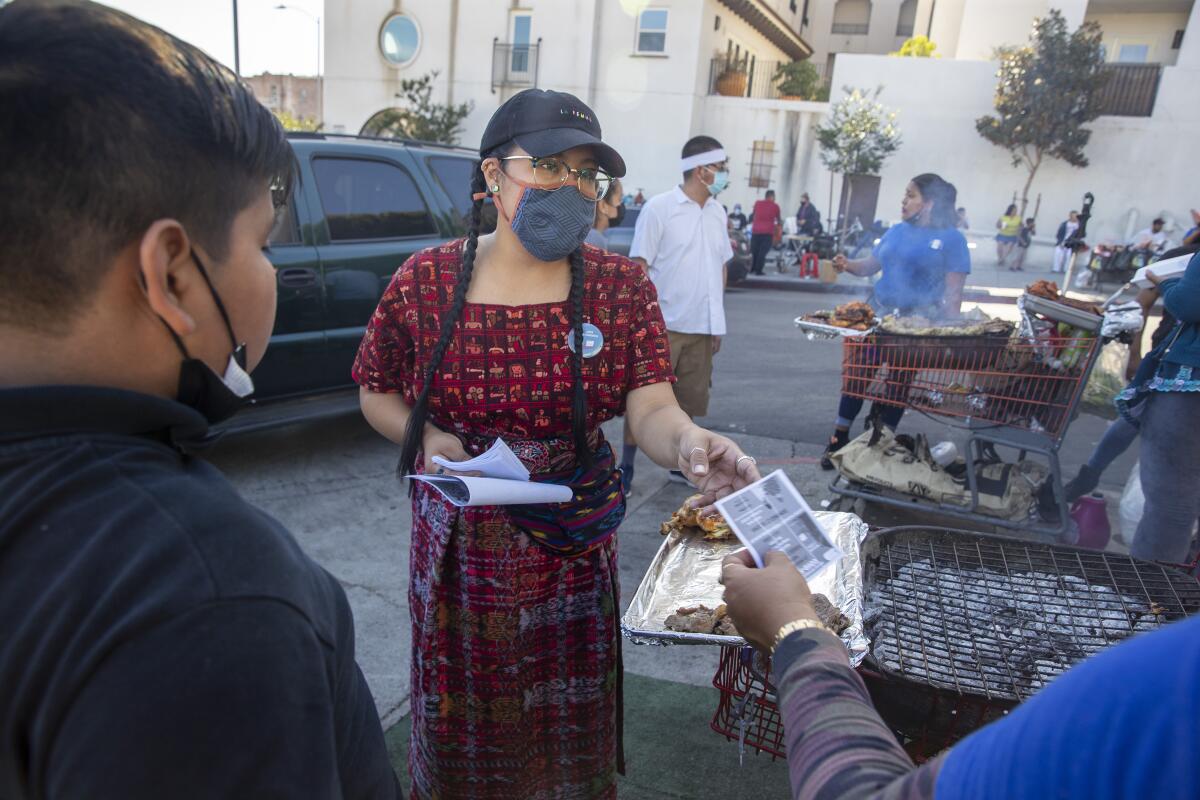
In an indoor shopping plaza, Francisco Hernandez, a 36-year-old electronics vendor from Guatemala’s region of Totonicapan, told the women he spoke K’iche’. He said he had recently given one of their fliers to a Maya man who he suspected lacked information about the vaccine.
“I explained to him in my language,” he said.
Nearby, Elizabeth Huinac, 33, also from Totonicapan, sold baby clothes. She told the women that she and most of her family hadn’t been vaccinated because of doubts about whether the vaccine worked or was safe.
But she said she was now inclined to get it, encouraged by hearing from others — such as the outreach workers — who had done so.
“It takes away a bit of the fear,” she said.
More to Read
Sign up for Essential California
The most important California stories and recommendations in your inbox every morning.
You may occasionally receive promotional content from the Los Angeles Times.
